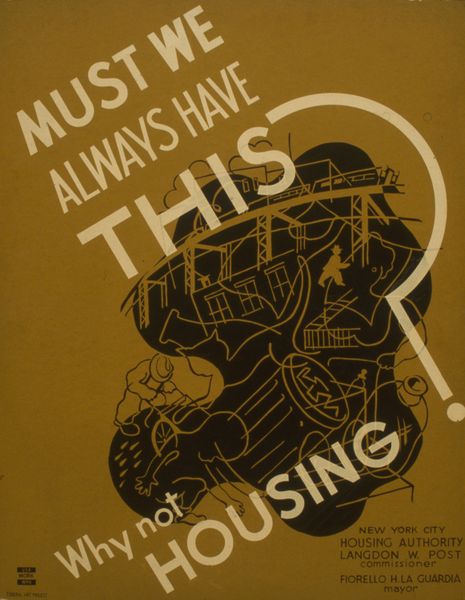Opening this week in Chicago, the National Public Housing Museum wants to reinvigorate our interest in collective well-being by tackling dominant narratives—of crime, poverty, and eventual destruction—head on.

A 1936 advertisement for the New York City Housing Authority depicts the clamor of city life: a jumble of line drawings depict a leaping alley cat, trash can, train, and fire escape. Bold text in a quintessential Art Deco font plastered diagonally across the image reads, "Must we always have this? Why not HOUSING?," addressing both the energy and desperation of urban life in 1930s America. Funded by the Works Progress Administration, the ad was of a time when the federal government created massive public works projects across America to uplift the poor during the Great Depression.

A 1936 poster promoting planned housing as the solution to a host of inner-city problems shows an inkblot on which elements of inner-city life are drawn.
Photo courtesy Library of Congress
Though that era is now long over, the ad still feels relevant. We’ve reached a record high of unhoused people across the country: new housing construction is slow, rent costs burden more than 50 percent of Americans, and building housing is only getting more expensive. We may have driverless taxis coasting through cities and technology that delivers anything you desire in a matter of hours…but why not housing, indeed?
The advertisement is one of many artifacts on display at the new National Public Housing Museum (NPHM) in Chicago, the country’s only museum devoted to U.S. public housing, which opens April 4. Unlike other types of history museums which seek to keep the past alive, the NPHM is in a unique position because public housing itself isn’t, technically, extinct. People still inhabit public housing developments constructed across the country after the U.S. Congress committed to building public housing in the National Housing Acts of 1935 and 1937. As such, the NPHM is doing something a bit different. They’re not preserving objects and artifacts to encase public housing in amber; instead, the space squarely seeks to reinvigorate our interest in collective well-being by tackling public housing’s dominant narrative—one of crime, poverty, and eventual destruction—head on.
Located in Chicago’s Little Italy neighborhood, the NPHM is housed in the remaining structure that was once part of the Jane Addams Homes—a 1937 low-rise public housing development that was mostly demolished beginning in 2002. According to NPHM executive director Lisa Lee, the building itself is the museum’s biggest artifact, saved by a group of former public housing residents when the City of Chicago embarked on its 1999 Plan for Transformation that got rid of 18,000 public housing units and displaced more than 16,000 people. At that point, it had been the largest net loss of affordable housing in the entire United States, says Lee.

An exterior view of Chicago’s (now mostly demolished) Jane Addams Homes in 1949.
Photo by Hedrich-Blessing Collection/Chicago History Museum/Getty Images

An archival photo shows children playing in fountains and on animal sculptures in the courtyard of the Jane Addams Homes public housing project.
Photo by Hedrich-Blessing Collection/Chicago History Museum/Getty Images
See the full story on Dwell.com: Why We Need the Nation’s First Public Housing Museum
Related stories:

No comments:
Post a Comment